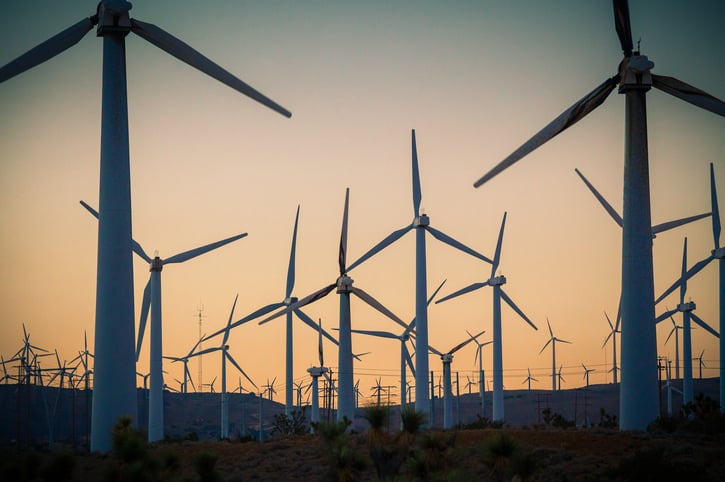Here’s to another solid quarter for U.S. wind power: According to the American Wind Energy Association’s (AWEA) freshly released fourth-quarter report, the sector just had its second-strongest quarter ever for newly installed capacity.
In addition, wind has now surpassed hydropower dams to become the largest source of renewable electric capacity in the U.S., AWEA has announced.
Stakeholders from General Motors (GM) and the U.S. wind energy industry met this morning to mark the milestones and release AWEA’s “Fourth Quarter 2016 U.S. Wind Industry Market Report” at GM’s Arlington, Texas, assembly plant – which will soon be 100% powered by wind.
“American wind power is now the No. 1 source of renewable capacity, thanks to more than 100,000 wind workers across all 50 states,” states Tom Kiernan, AWEA’s CEO. “Growing this made-in-the-USA clean energy resource helps rural communities pay for new roads, bridges and schools while bringing back manufacturing jobs to the Rust Belt. With our two-thirds cost reduction over the last seven years, household brands like General Motors, Walmart and more are buying low-cost wind energy to cut costs and power their businesses. American wind power is on track to double our output over the next five years and supply 10 percent of U.S. electricity by 2020.”
At the close of 2016, the American wind fleet totaled 82,183 MW, which is enough to power 24 million average American homes. Specifically, there are now more than 52,000 individual wind turbines in 41 states, plus Guam and Puerto Rico.
GM’s Arlington plant, which produces over 1,000 SUVs a day, is currently 50% powered by wind energy. However, starting in 2018, it will be GM’s first plant to have all of its electricity needs met with wind energy. The company purchases energy from two Texas wind farms, RES’ Cactus Flats in Concho County and EDPR’s Los Mirasoles Wind Farm in Edinburg.
To that end, notes AWEA, non-utility purchasers – such as GM, Microsoft and the U.S. Department of Defense – represented 39% of wind purchased through long-term contracts in 2016 for a total of 1,574 MW. Notably, more than half of that capacity is located in Texas.
On the jobs front, according to the report, the wind industry now employs 25,000 Americans at more than 500 factories in 43 states (including 40 wind manufacturing facilities in Texas alone). In 2016, at least seven companies across the U.S. expanded existing manufacturing facilities to meet growing orders, and GRI Renewable Industries opened a new tower facility in Amarillo, Texas. Citing a recent U.S. Department of Energy report, AWEA says a total of more than 100,000 American workers now manufacture, construct and maintain the U.S. wind turbine fleet.
As for new growth in the fourth quarter of 2016, 6,478 MW of wind was installed – representing the second-strongest quarter on record, says AWEA.
For the year, wind developers added 8,203 MW of wind power capacity, representing more than $13.8 billion in new investment. With 99% of wind projects located in rural areas, much of this investment is flowing to communities that need it most, the association notes.
Specifically, rural and Rust Belt America are among the greatest beneficiaries of wind development. Wind projects in these areas often become the largest contributors to the property tax base – in turn, helping to improve schools, roads and other public services. Of the $13.8 billion invested by the U.S. wind industry last year, $10.5 billion was invested in low-income counties, according to the report.
AWEA points out that wind is also a new drought-resistant cash crop for farmers and ranchers who host turbines on their land. Nationwide, wind projects provide private landowners with more than $245 million in land lease payments annually. In particular, Texas landowners receive more than $60 million of that.
“Wind power isn’t a red or blue industry; it’s red, white and blue,” says Kiernan. “Low-cost, homegrown wind energy is something we can all agree on. States like Texas and Iowa are leading the way in terms of wind turbines and wind jobs.”
According to AWEA, Texas is the undisputed leader in wind energy: It has approximately three times more wind generating capacity than any other state and hosts nearly a quarter of American wind jobs.
Texas, continuing to expand its wind industry, became the first state to pass 20,000 MW of wind capacity last year (which is roughly one-fourth of national capacity).
And more wind is on the way in Texas: Even with the 1,790 MW installed in the fourth quarter of 2016, there is still 5,401 MW under construction and another 1,288 MW in advanced development.
“With more wind energy production and more wind workers than any other state, if you want to know how wind works for America, just ask a Texan,” quips Kiernan.
The report says a key part of the success story in Texas has been a strong backbone of transmission infrastructure, including the Competitive Renewable Energy Zone transmission lines. Looking ahead, transmission projects, such as Pattern Development’s proposed Southern Cross Transmission Project, will allow the state to benefit by exporting its abundant wind energy to customers in the Southeast.
AWEA notes that wind growth is now spreading up from Texas into the Plains states and across the Midwest; in fact, 89% of newly completed capacity in 2016 was found in these states.
Notably, the U.S. offshore wind industry also launched in the fourth quarter of 2016 when the 30 MW Block Island Wind Farm, located off the coast of Rhode Island, was commissioned. Gulf Island Fabrication in Louisiana manufactured the foundations for the project – reflecting a broader opportunity for oil and gas suppliers to earn additional business in offshore wind, AWEA points out.
Now that the generating capacity of U.S. wind turbines stands at over 82,000 MW – greater than the 80,000 MW of hydropower generating capacity – wind is now the fourth-largest source of U.S. generating capacity (behind gas, goal and nuclear), the report concludes.




